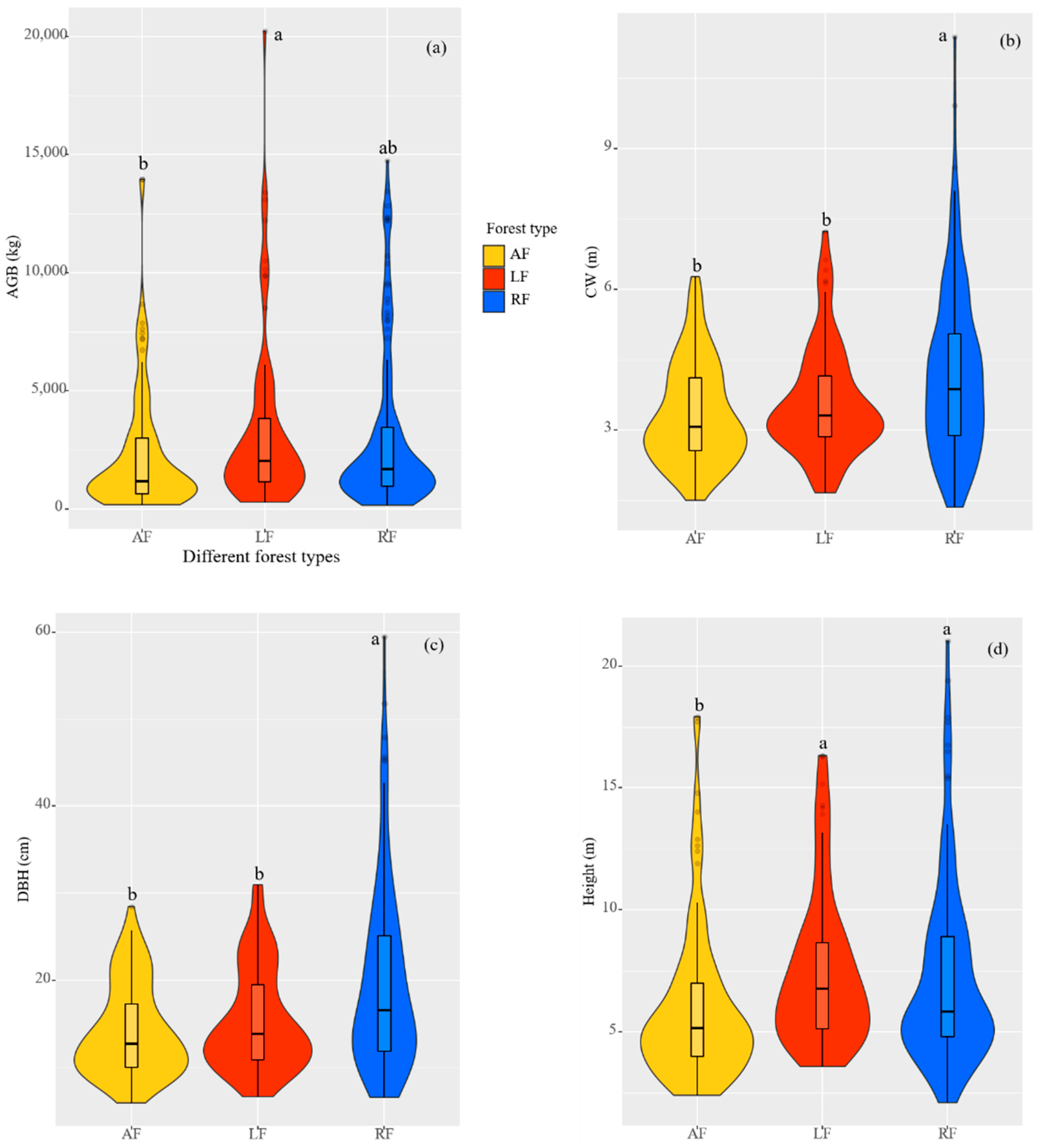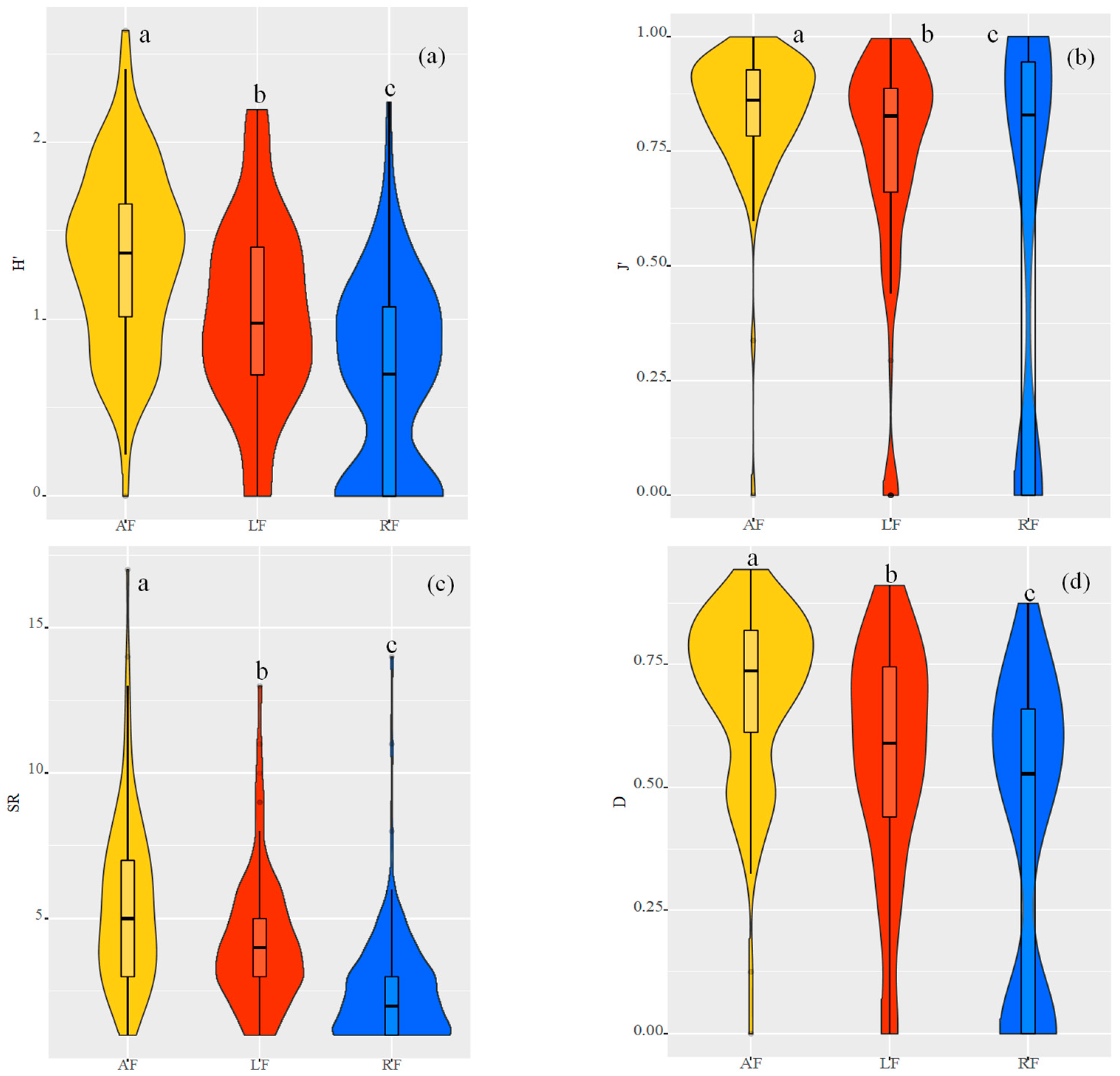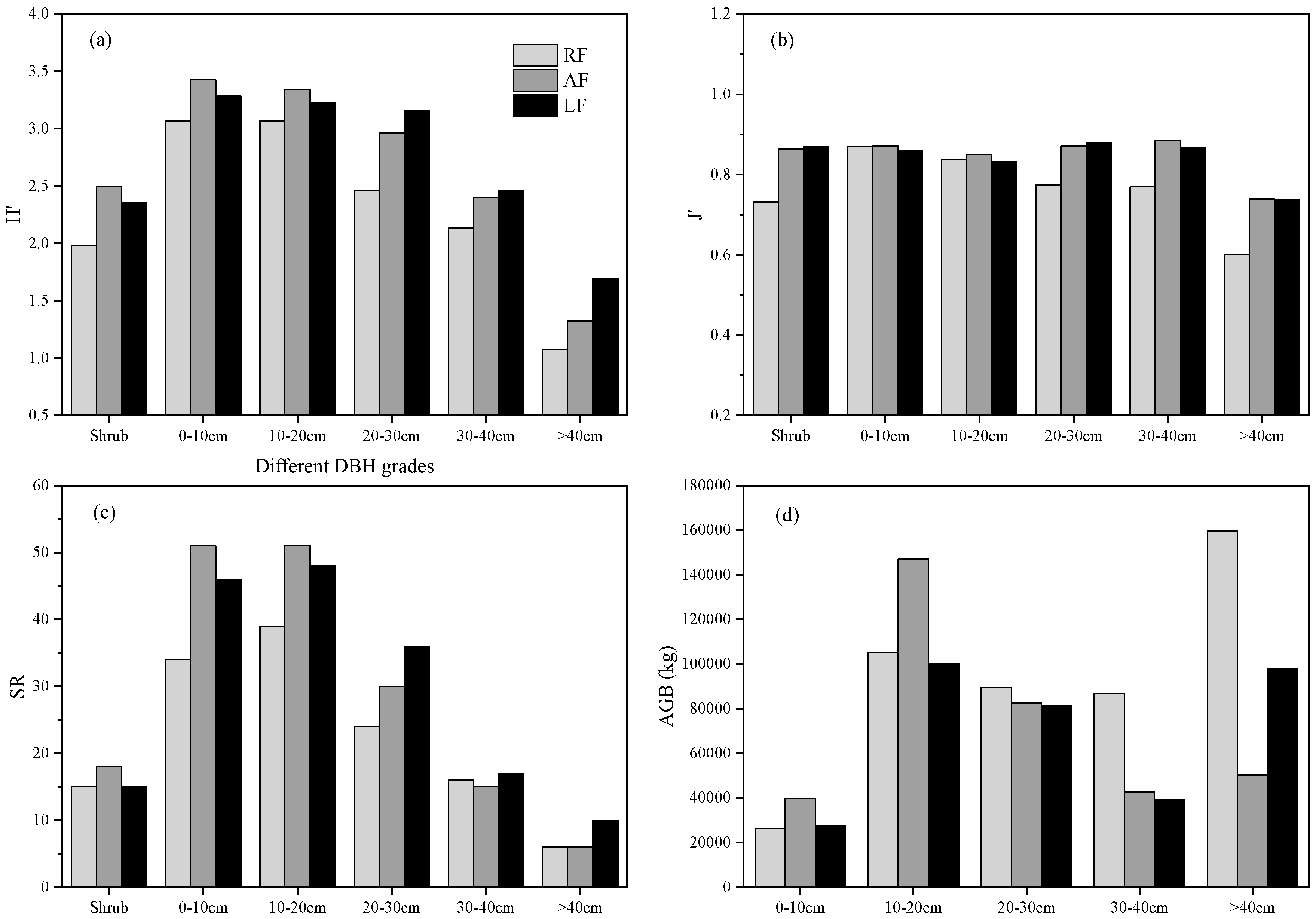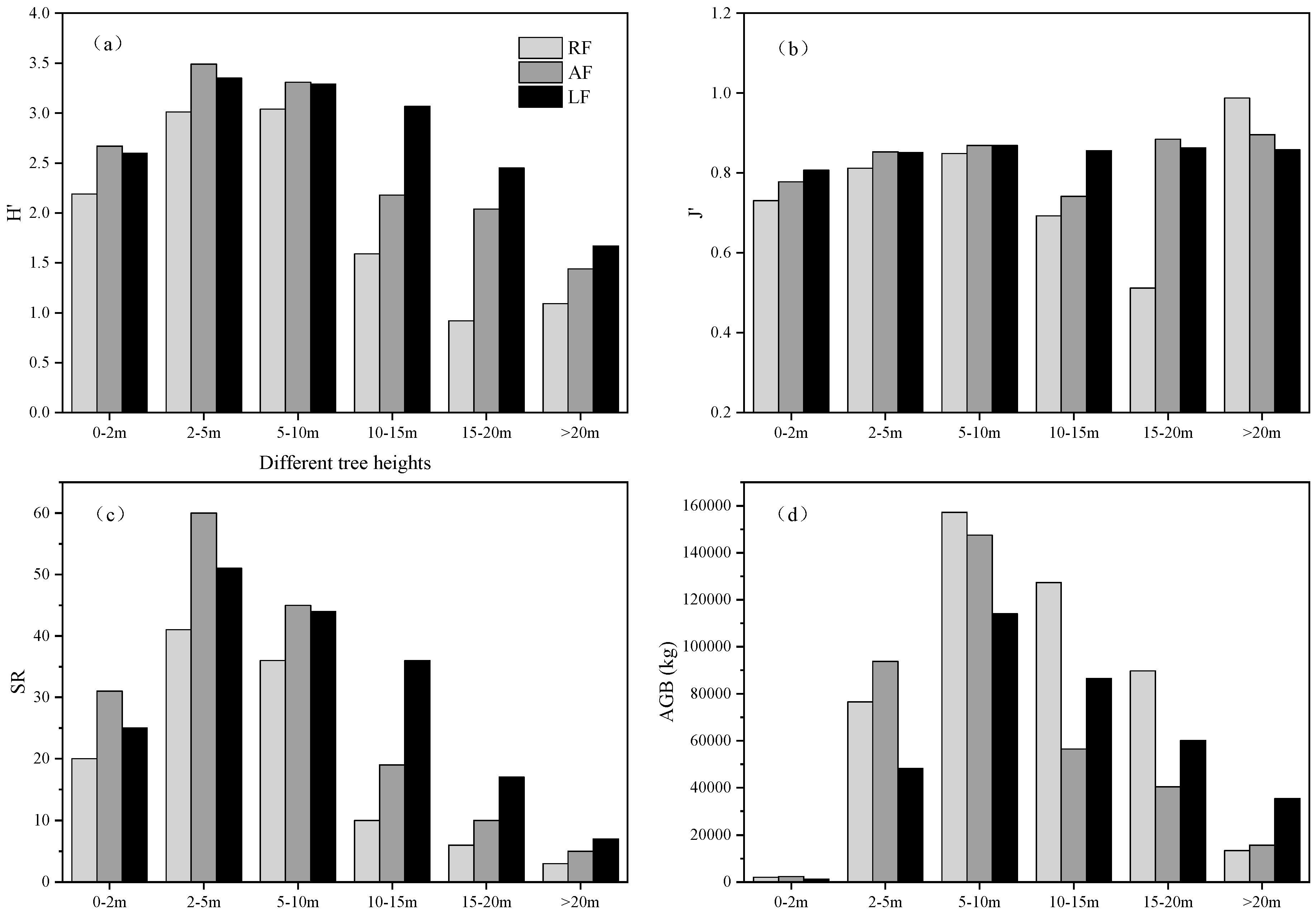Effects of Structural and Diversity Attributes on Biomass in Different Types of Urban Forests in Changchun, Northeast China, and Suggestions for Urban Forest Planning
Abstract
:1. Introduction
2. Materials and Methods
2.1. Study Sites
2.2. Fieldwork and Plot Design
2.3. Urban Forest Plant Diversity attributes and Biomass Calculation
2.4. Statistical Analysis
3. Results
3.1. Distribution of Structural and Diversity Attributes
3.2. Species Diversity and AGB of Different DBH Grades
3.3. Species Diversity and AGB of Different Tree Height Grades
3.4. Relationship between Structure Attributes, Diversity Attributes and Above-Ground Biomass
4. Discussion
4.1. Differences in Structural and Diversity Attributes among Different Types of Urban Forests
4.2. Attributes of Diversity and Biomass Distribution between Different DBH Grades and Tree Height Grades
4.3. Relationship between Structural Attributes, Diversity Attributes and Biomass of Urban Forests
5. Conclusions
Author Contributions
Funding
Acknowledgments
Conflicts of Interest
Appendix A
| Latin Name | Allometric Growth Equation | Reference | |||
|---|---|---|---|---|---|
| Platycladus | Bag = Bstem + Bbranch + Bleaf | Bstem = 131.38 × (D2H) 0.5968 + 36.31 × (D2H) 0.6759 | Bbranch = 27.41 × (D2H) 0.5974 + 49.66 × (D2H) 0.5978 + 5.52 × (D2H) 0.5876 | Bleaf = 37.86 × (D2H) 0.5977 | [30] |
| Pinus sylvestris L.var. mongolica | Bag = Bstem + Bbranch + Bleaf | Bstem = 0.0438 × (D2H) 0.8862 | Bbranch = 0.02388 × D4.1913H–2.3076 | Bleaf = 0.1083 × D2.7169H–1.3955 | [31] |
| Juglans mandshurica | Bag = 0.1717 × D2.286 | [33] | |||
| Betula platyphylla | Bag = 0.1443 × D2.366 | [33] | |||
| Pinus koraiensis | Bag = 0.1723 × D2.143 | [33] | |||
| Populus | Bag = 0.066 × D2.557 | [33] | |||
| Phellodendron amurense | Bag = 0.0876 × D2.330 | [33] | |||
| Larix gmelinii | Bag = 0.0947 × D2.451 | [33] | |||
| Arbor General Equation | Bag = 0.0881 × D2.466 | [33] | |||
| Acer | Bag = 0.0851 × D2.534 | [33] | |||
| Fraxinus | Bag = 0.1369 × D2.409 | [33] | |||
| Tilia | Bag = 0.0403 × D2.658 | [33] | |||
| Quercus mongolica | Bag = 0.1006 × D2.455 | [33] | |||
| Spiraea salicifolia | Bag = 0.0931 × CAH0.913 | [34] | |||
| Shrubs General Equation | Bag = 0.1008 × CAH0.926 | [34] | |||
| Philadelphus schrenkii | Bag = 0.0345 × H2.50 | [34] | |||
| Lonicera | Bag = 0.1809 × CA1.395 | [34] | |||
| Pinus tabulaeformis | Bag = Bstem + Bbranch + Blea | Bstem = 0.11 × D2.35 | Bbranch = 0.01 × D2.59 | Bleaf = 0.0049 × D2.49 | [35] |
| Ulmus | Bag = Bstem + Bbranch + Blea | Bstem = 0.044 × D2.87 | Bbranch = 0.0075 × D2.67 | Bleaf = 0.0029 × D2.50 | [35] |
| Robinia pseudoacacia | Bag = Bstem + Bbranch + Blea | Bstem = 0.069 × D2.53 | Bbranch = 0.068 × D1.88 | Bleaf = 0.0014 × D3.27 | [35] |
| Picea asperata | Bag = Bstem + Bbranch + Blea | Bstem = 0.058 × D2.49 | Bbranch = 0.013 × D2.42 | Bleaf = 0.082 × D2.36 | [35] |
References
- Alvey, A.A. Promoting and preserving biodiversity in the urban forest. Urban For. Urban Green. 2006, 5, 195–201. [Google Scholar] [CrossRef]
- Moro, M.F.; Castro, A.S.F. A check list of plant species in the urban forestry of Fortaleza, Brazil: Where are the native species in the country of megadiversity? Urban Ecosyst. 2014, 18, 47–71. [Google Scholar] [CrossRef]
- Zhang, D.; Wang, W.; Zheng, H.; Ren, Z.; Zhai, C.; Tang, Z.; Shen, G.; He, X. Effects of urbanization intensity on forest structural-taxonomic attributes, landscape patterns and their associations in Changchun, Northeast China: Implications for urban green infrastructure planning. Ecol. Indic. 2017, 80, 286–296. [Google Scholar] [CrossRef]
- Kendal, D.; Dobbs, C.; Lohr, V.I. Global patterns of diversity in the urban forest: Is there evidence to support the 10/20/30 rule? Urban For. Urban Green. 2014, 13, 411–417. [Google Scholar] [CrossRef]
- Dallimer, M.; Irvine, K.N.; Skinner, A.M.J.; Davies, Z.G.; Rouquette, J.R.; Maltby, L.; Warren, P.H.; Armsworth, P.; Gaston, K.J. Biodiversity and the Feel-Good Factor: Understanding Associations between Self-Reported Human Well-being and Species Richness. BioScience 2012, 62, 47–55. [Google Scholar] [CrossRef] [Green Version]
- Nowak, D.J.; Hoehn, R.E.; Bodine, A.R.; Greenfield, E.J.; O’Neil-Dunne, J. Urban forest structure, ecosystem services and change in Syracuse, NY. Urban Ecosyst. 2016, 19, 1455–1477. [Google Scholar] [CrossRef]
- Escobedo, F.J.; Clerici, N.; Staudhammer, C.L.; Corzo, G.T. Socio-ecological dynamics and inequality in Bogotá, Colombia’s public urban forests and their ecosystem services. Urban For. Urban Green. 2015, 14, 1040–1053. [Google Scholar] [CrossRef]
- Cavanaugh, K.C.; Gosnell, J.S.; Davis, S.L.; Ahumada, J.; Boundja, P.; Clark, D.B.; Mugerwa, B.; Jansen, P.; O’Brien, T.G.; Rovero, F.; et al. Carbon storage in tropical forests correlates with taxonomic diversity and functional dominance on a global scale. Glob. Ecol. Biogeogr. 2014, 23, 563–573. [Google Scholar] [CrossRef]
- Paquette, A.; Messier, C. The effect of biodiversity on tree productivity: From temperate to boreal forests. Glob. Ecol. Biogeogr. 2011, 20, 170–180. [Google Scholar] [CrossRef] [Green Version]
- Li, Y.; Dong, S.; Liu, S.; Su, X.; Wang, X.; Zhang, Y.; Zhao, Z.; Gao, X.; Li, S.; Tang, L. Relationships between plant diversity and biomass production of alpine grasslands are dependent on the spatial scale and the dimension of biodiversity. Ecol. Eng. 2019, 127, 375–382. [Google Scholar] [CrossRef]
- Vilà, M.; Inchausti, P.; Vayreda, J.; Barrantes, O.; Gracia, C.; Ibáñez, J.J.; Mata, T. Confounding Factors in the Observational Productivity-Diversity Relationship in Forests. In Forest Diversity and Function: Temperate and Boreal Systems; Scherer-Lorenzen, M., Körner, C., Schulze, E.-D., Eds.; Springer: Berlin/Heidelberg, Germany, 2005; pp. 65–86. [Google Scholar] [CrossRef]
- Mensah, S.; du Toit, B.; Seifert, T. Diversity–biomass relationship across forest layers: Implications for niche complementarity and selection effects. Oecologia 2018, 187, 783–795. [Google Scholar] [CrossRef] [PubMed]
- Naeem, S.; Duffy, J.E.; Zavaleta, E. The Functions of Biological Diversity in an Age of Extinction. Science 2012, 336, 1401–1406. [Google Scholar] [CrossRef] [PubMed] [Green Version]
- Pyles, M.V.; Prado-Junior, J.A.; Magnago, L.F.S.; de Paula, A.; Meira-Neto, J.A.A. Loss of biodiversity and shifts in aboveground biomass drivers in tropical rainforests with different disturbance histories. Biodivers. Conserv. 2018, 27, 3215–3231. [Google Scholar] [CrossRef]
- Hooper, D.U.; Vitousek, P.M. The Effects of Plant Composition and Diversity on Ecosystem Processes. Science 1997, 277, 1302–1305. [Google Scholar] [CrossRef] [Green Version]
- Tilman, D.; Wedin, D.; Knops, J. Productivity and sustainability influenced by biodiversity in grassland ecosystems. Nature 1996, 379, 718–720. [Google Scholar] [CrossRef]
- Ni, J.; Wang, G.; Bai, Y.; Li, X. Scale-dependent relationships between plant diversity and above-ground biomass in temperate grasslands, south-eastern Mongolia. J. Arid Environ. 2007, 68, 132–142. [Google Scholar] [CrossRef]
- Zhang, Y.; Chen, H.Y.H.; Reich, P.B. Forest productivity increases with evenness, species richness and trait variation: A global meta-analysis. J. Ecol. 2012, 100, 742–749. [Google Scholar] [CrossRef]
- Li, S.; Su, J.; Lang, X.; Liu, W.; Ou, G. Positive relationship between species richness and aboveground biomass across forest strata in a primary Pinus kesiya forest. Sci. Rep. 2018, 8, 2227. [Google Scholar] [CrossRef] [PubMed] [Green Version]
- Yuan, Z.; Wang, S.; Ali, A.; Gazol, A.; Ruiz-Benito, P.; Wang, X.; Lin, F.; Ye, J.; Hao, Z.; Loreau, M. Aboveground carbon storage is driven by functional trait composition and stand structural attributes rather than biodiversity in temperate mixed forests recovering from disturbances. Ann. For. Sci. 2018, 75, 67. [Google Scholar] [CrossRef]
- Prado-Junior, J.A.; Schiavini, I.; Vale, V.S.; Arantes, C.S.; van der Sande, M.T.; Lohbeck, M.; Poorter, L. Conservative species drive biomass productivity in tropical dry forests. J. Ecol. 2016, 104, 817–827. [Google Scholar] [CrossRef] [Green Version]
- Ali, A.; Yan, E.-R.; Chen, H.Y.H.; Chang, S.X.; Zhao, Y.-T.; Yang, X.-D.; Xu, M.-S. Stand structural diversity rather than species diversity enhances aboveground carbon storage in secondary subtropical forests in Eastern China. Biogeosciences 2016, 13, 4627–4635. [Google Scholar] [CrossRef] [Green Version]
- Chang, Y.; Wang, Z.; Zhang, D.; Fu, Y.; Zhai, C.; Wang, T.; Yang, Y.; Wu, J. Analysis of Urban Woody Plant Diversity among Different Administrative Districts and the Enhancement Strategy in Changchun City, China. Sustainability 2022, 14, 7624. [Google Scholar] [CrossRef]
- Baran, J.; Pielech, R.; Kauzal, P.; Kukla, W.; Bodziarczyk, J. Influence of forest management on stand structure in ravine forests. For. Ecol. Manag. 2020, 463, 118018. [Google Scholar] [CrossRef]
- Likongwe, P.J.; Chimaimba, F.B.; Chiotha, S.S.; Mandevu, T.; Kamuyango, L.; Garekae, H. Urban Community Power: Enhancing Urban Forest Diversity and Reversing Ecosystem Disservices in Zomba City, Malawi. Land 2021, 10, 1258. [Google Scholar] [CrossRef]
- Borges, E.R.; Dexter, K.G.; Pyles, M.V.; Bueno, M.L.; dos Santos, R.M.; Fontes, M.A.L.; Carvalho, F.A. The interaction of land-use history and tree species diversity in driving variation in the aboveground biomass of urban versus non-urban tropical forests. Ecol. Indic. 2021, 1291, 107915. [Google Scholar] [CrossRef]
- Carrus, G.; Scopelliti, M.; Lafortezza, R.; Colangelo, G.; Ferrini, F.; Salbitano, F.; Agrimi, M.; Portoghesi, L.; Semenzato, P.; Sanesi, G. Go greener, feel better? The positive effects of biodiversity on the well-being of individuals visiting urban and peri-urban green areas. Landsc. Urban Plan. 2015, 134, 221–228. [Google Scholar] [CrossRef]
- Changchun Statistics Bureau. Statistical Bulletin of Changchun National Economic and Social Development in 2020; Changchun Daily: Changchun, China, 2021; p. 007. [Google Scholar]
- He, X.; Liu, C.; Chen, W.; Guan, Z.; Zhao, G. Exploring the classification of urban forests. J. Ecol. 2004, 23, 175–178. [Google Scholar] [CrossRef]
- Chang, X.; Che, K.; Song, C.; Wang, J.; Li, B. Biomass and Nutrient Element Accumulation of Sabina Prezewalskii Forest Community. J. Northwest For. Coll. 1997, 12, 23–28. [Google Scholar]
- Jia, W.; Jiang, S.; Li, F. Biomass of Single Tree of Pinus Sylvestris Var. Mongolica in Eastern Heilongjiang. Liaoning For. Sci. Technol. 2008, 3, 5–9. [Google Scholar] [CrossRef]
- Zhang, D.; Zheng, H.; Ren, Z.; Zhai, C.; Shen, G.; Mao, Z.; Wang, P.; He, X. Effects of forest type and urbanization on carbon storage of urban forests in Changchun, Northeast China. Chin. Geogr. Sci. 2015, 25, 147–158. [Google Scholar] [CrossRef]
- Wang, C. Biomass allometric equations for 10 co-occurring tree species in Chinese temperate forests. For. Ecol. Manag. 2006, 222, 9–16. [Google Scholar] [CrossRef]
- Li, X.; Guo, Q.; Wang, X.; Zheng, H. Allometry of Understory Tree Species in a Natural Secondary Forest in Northeast China. Sci. Silvae Sin. 2010, 46, 22–32. [Google Scholar] [CrossRef]
- Liu, C.; Li, X. Carbon storage and sequestration by urban forests in Shenyang, China. Urban For. Urban Green. 2012, 11, 121–128. [Google Scholar] [CrossRef]
- Zhang, D.; Zheng, H.; He, X.; Ren, Z.; Zhai, C.; Yu, X.; Mao, Z.; Wang, P. Effects of forest type and urbanization on species composition and diversity of urban forest in Changchun, Northeast China. Urban Ecosyst. 2016, 19, 455–473. [Google Scholar] [CrossRef]
- Rosseel, Y. Lavaan: An R package for structural equation modeling and more. Version 0.5–12 (BETA). J. Stat. Softw. 2012, 48, 1–36. [Google Scholar] [CrossRef] [Green Version]
- Nizamani, M.M.; Harris, A.; Cheng, X.; Zhu, Z.; Jim, C.Y.; Wang, H. Positive relationships among aboveground biomass, tree species diversity, and urban greening management in tropical coastal city of Haikou. Ecol. Evol. 2021, 11, 12204–12219. [Google Scholar] [CrossRef]
- Hu, H.; Ye, J.; Liu, B.; Mao, L.; Smith, S.A.; Barrett, R.L.; Soltis, P.S.; Soltis, D.E.; Chen, Z.; Lu, L. Temporal and spatial comparisons of angiosperm diversity between eastern Asia and North America. Natl. Sci. Rev. 2022, 9, nwab199. [Google Scholar] [CrossRef]
- Ding, X.; Liu, G.; Fu, S.; Chen, H.Y. Tree species composition and nutrient availability affect soil microbial diversity and composition across forest types in subtropical China. CATENA 2021, 201, 105224. [Google Scholar] [CrossRef]
- Liu, C.Y.; Fang, W.J.; Cai, Q.; Ma, S.H.; Ji, C.J.; Fang, J.Y. Allometric Relationship between Tree Height and Diameter of Larch Forests in China. Acta. Sci. Nat. Univ. Pekin. 2017, 53, 1081–1088. [Google Scholar] [CrossRef]
- Wang, W.; Xiao, L.; Lyu, H.; Xu, H.; Zhang, B.; Zhou, W.; He, X. Structural Characteristics and Ecological Service Functions of Urban Forests: A Case Study of Harbin. In Proceedings of the 16th National Member Congress and 85th Anniversary Annual Meeting of the Botanical Society of China, Kunming, China, 10–13 October 2018; pp. 409–410. [Google Scholar]
- Feng, Y.; Ziegler, A.D.; Elsen, P.R.; Liu, Y.; He, X.; Spracklen, D.V.; Holden, J.; Jiang, X.; Zheng, C.; Zeng, Z. Upward expansion and acceleration of forest clearance in the mountains of Southeast Asia. Nat. Sustain. 2021, 4, 892–899. [Google Scholar] [CrossRef]
- Liu, D.; Zhou, C.; Keesing, J.K.; Serrano, O.; Werner, A.; Fang, Y.; Chen, Y.; Masque, P.; Kinloch, J.; Sadekov, A.; et al. Wildfires enhance phytoplankton production in tropical oceans. Nat. Commun. 2022, 13, 1348. [Google Scholar] [CrossRef] [PubMed]
- Forzieri, G.; Girardello, M.; Ceccherini, G.; Spinoni, J.; Feyen, L.; Hartmann, H.; Beck, P.S.A.; Camps-Valls, G.; Chirici, G.; Mauri, A.; et al. Emergent vulnerability to climate-driven disturbances in European forests. Nat. Commun. 2021, 12, 1081. [Google Scholar] [CrossRef] [PubMed]
- Gaggini, L.; Rusterholz, H.-P.; Baur, B. Settlements as a source for the spread of non-native plants into Central European suburban forests. Acta Oecologica 2017, 79, 18–25. [Google Scholar] [CrossRef]
- Vilà, M.; Vayreda, J.; Gracia, C.; Ibáñez, J.J. Does tree diversity increase wood production in pine forests? Oecologia 2003, 135, 299–303. [Google Scholar] [CrossRef]
- Larpkern, P.; Totland, Ø.; Moe, S.R. Do disturbance and productivity influence evenness of seedling, sapling and adult tree species across a semi-deciduous tropical forest landscape? Oikos 2011, 120, 623–629. [Google Scholar] [CrossRef]
- Li, Y.; Zhang, Q.-B. History of Tree Growth Declines Recorded in Old Trees at Two Sacred Sites in Northern China. Front. Plant Sci. 2017, 8, 1779. [Google Scholar] [CrossRef] [Green Version]
- Xiong, M.; Long, W.; Yang, X.; Huang, J.; Li, S.; Lin, M.; Wang, Q.; Lin, D.; Kang, Y. Relationship between Plant Species Diversity and Habitat in a Tropical Moist Forest. J. Zhejiang For. Sci. Technol. 2015, 35, 18–23. [Google Scholar] [CrossRef]
- Li, Z.; Tang, J.-W.; Zheng, Z.; Zhu, S.; Duan, W.; Song, J.; Guo, X.; Zeng, R. Tree species diversity of tropical montane rain forest in Xishuangbanna, Yunnan. Ying Yong Sheng Tai Xue Bao J. Appl. Ecol. 2005, 16, 1183–1188. [Google Scholar]
- Wang, X.; Dallimer, M.; Scott, C.E.; Shi, W.; Gao, J. Tree species richness and diversity predicts the magnitude of urban heat island mitigation effects of greenspaces. Sci. Total Environ. 2021, 770, 145211. [Google Scholar] [CrossRef]
- Chen, G.; Yang, Y.; Yang, Z.; Xie, J.; Guo, J.; Gao, R.; Yin, Y.; Robinson, D. Accelerated soil carbon turnover under tree plantations limits soil carbon storage. Sci. Rep. 2016, 6, 19693. [Google Scholar] [CrossRef] [Green Version]
- Luna-Kamyshev, N.M.; López-Martínez, J.O.; Vargas-Larreta, B.; Islebe, G.A.; Villalobos-Guerrero, T.F.; De La Rosa, A.V.; Reyes-Mendoza, O.; Treviño-Garza, E. Floristic Composition, Diversity, and Biomass of a Protected Tropical Evergreen Forest Belize. Trop. Conserv. Sci. 2020, 13, 1940082920915433. [Google Scholar] [CrossRef]
- Yan, H.; Sun, Y.; Liu, B. Effects of Competition on Drought Adaptability and Growth Decline of Pinus Koraiensis Trees. J. Beijing For. Univ. 2022, 44, 1–9. [Google Scholar] [CrossRef]
- Cardinale, B.J.; Wright, J.P.; Cadotte, M.W.; Carroll, I.T.; Hector, A.; Srivastava, D.S.; Loreau, M.; Weis, J.J. Impacts of plant diversity on biomass production increase through time because of species complementarity. Proc. Natl. Acad. Sci. USA 2007, 104, 18123–18128. [Google Scholar] [CrossRef] [PubMed] [Green Version]
- Zimudzi, C.; Chapano, C. Diversity, Population Structure, and Above Ground Biomass in Woody Species on Ngomakurira Mountain, Domboshawa, Zimbabwe. Int. J. Biodivers. 2016, 2016, 4909158. [Google Scholar] [CrossRef]






| Quadrat | No. Tree | Species Richness | Average DBH (cm) | Average Height (m) | Dominant Species |
|---|---|---|---|---|---|
| AF | 2508 | 60 | 14.10 | 5.99 | Picea koraiensis Nakai. |
| Amygdalus persica L. var. persica f. duplex Rehd. | |||||
| Salix matsudana Koidz. | |||||
| Syringa oblata Lindl. | |||||
| LF | 2122 | 51 | 7.35 | Pinus sylvestris var. mongolica Litv. | |
| 15.35 | Fraxinus mandshurica Rupr. | ||||
| Quercus mongolica Fisch. ex Ledeb. | |||||
| RF | 2436 | 41 | 17.33 | 7.26 | Salix matsudana Koidz. |
| Populus davidiana Dode. | |||||
| Pinus sylvestris var. mongolica Litv. | |||||
| Prunus triloba Lindl. | |||||
| Ulmus densa Litw. | |||||
| Prunus ussuriensis Kov. et Kost. |
Publisher’s Note: MDPI stays neutral with regard to jurisdictional claims in published maps and institutional affiliations. |
© 2022 by the authors. Licensee MDPI, Basel, Switzerland. This article is an open access article distributed under the terms and conditions of the Creative Commons Attribution (CC BY) license (https://creativecommons.org/licenses/by/4.0/).
Share and Cite
Wu, J.; Wang, Z.; Zhang, D.; Gong, C.; Zhai, C.; Wang, Y. Effects of Structural and Diversity Attributes on Biomass in Different Types of Urban Forests in Changchun, Northeast China, and Suggestions for Urban Forest Planning. Forests 2022, 13, 1805. https://doi.org/10.3390/f13111805
Wu J, Wang Z, Zhang D, Gong C, Zhai C, Wang Y. Effects of Structural and Diversity Attributes on Biomass in Different Types of Urban Forests in Changchun, Northeast China, and Suggestions for Urban Forest Planning. Forests. 2022; 13(11):1805. https://doi.org/10.3390/f13111805
Chicago/Turabian StyleWu, Junjie, Zihan Wang, Dan Zhang, Chao Gong, Chang Zhai, and Yuanyuan Wang. 2022. "Effects of Structural and Diversity Attributes on Biomass in Different Types of Urban Forests in Changchun, Northeast China, and Suggestions for Urban Forest Planning" Forests 13, no. 11: 1805. https://doi.org/10.3390/f13111805
APA StyleWu, J., Wang, Z., Zhang, D., Gong, C., Zhai, C., & Wang, Y. (2022). Effects of Structural and Diversity Attributes on Biomass in Different Types of Urban Forests in Changchun, Northeast China, and Suggestions for Urban Forest Planning. Forests, 13(11), 1805. https://doi.org/10.3390/f13111805








